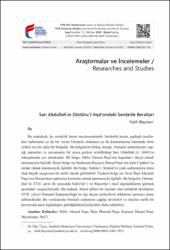Sarı Abdullah’ın Düstûru’l-İnşâ’sındaki Serdarlık Beratları
Künye
BAYRAM, Fatih. "Sarı Abdullah’ın Düstûru’l-İnşâ’sındaki Serdarlık Beratları." FSM İlmî Araştırmalar İnsan ve Toplum Bilimleri Dergisi, 15 (2020): 1-32.Özet
Bu makalede, üç serdarlık beratı incelenmektedir. Serdarlık beratı, padişah tarafından
sadrazama ya da bir vezire Osmanlı ordusuna ya da donanmasına kumanda etme
yetkisi tevcih eden bir belgedir. Bu belgelerin birkaç örneği, Osmanlı sultanlarının yaptığı
atamaları ve yazışmaları bir araya getiren reisülküttap Sarı Abdullah (ö. 1660)’ın
münşeâtında yer almaktadır. İlk belge, Hâfız Ahmed Paşa’nın kapudan-ı deryâ olarak
atanmasıyla ilgilidir. İkinci belge ise Sadrazam Kuyucu Murad Paşa’nın Şark Cephesi’ne
serdar olarak atanmasıyla ilgilidir. Bu belge, Sultan I. Ahmed’in yaşlı sadrazamına karşı
olan büyük saygısının bir delili olarak görülebilir. Üçüncü belge ise Vezir İbşir Mustafa
Paşa’nın Macaristan cephesine komutan olarak atanmasıyla ilgilidir. Bu belgeler, Osmanlılar’ın
XVII. asrın ilk yarısında Safevîler’i ve Macarlar’ı nasıl algıladıklarını görmek
açısından vazgeçilmezdir. Bu makale, ihmal edilen bir kaynak olan serdarlık beratlarını
XVII. yüzyıl Osmanlı İmparatorluğu’na ilgi duyan tarihçilerin dikkatine sunmayı amaç
edinmektedir. Bu vesikalarda Osmanlı sultanının çağdaş devletleri ve olayları tarihî bir
kavrayışla nasıl algıladığını gördüğümüzü kolaylıkla iddia edebiliriz. In this article, three appointmental documents called serdarlık beratı have been examined.
Serdarlık beratı is a kind of document which was bestowed by the Ottoman sultan
to the grand vizier or to one of the viziers in order to appoint him as the commander-in-chief
of the Ottoman army or admiral-in-chief of the Ottoman navy. A few examples of
these documents are kept in the reisülküttâb Sarı Abdullah (ö. 1660)’s münşeât, collection
of imperial edicts and correspondences of the Ottoman sultans. The first document is related
to the appointment of Hâfız Ahmed Paşa as Admiral-in-Chief of the Ottoman Navy.
The second document is related to Vizier Kuyucu Murad Paşa’s appointment as the Commander-
in-Chief of the Ottoman Army in the Eastern Front. This document can be seen as
an evidence of Sultan Ahmed I’s reverence for his old Grand Vizier. The third document
is related to the vizier İbşir Mustafa Paşa’s appointment as the commander-in-chief of
the Ottoman army in Hungary. These documents are an indispensable source in terms of
how the Ottomans viewed the Safavids and Hungarians in the first half of the seventeenth
century. The article aims at introducing a neglected source, i.e. serdarlık berats, to the
historians who are interested in the seventeenth-century Ottoman empire. It can safely be
argued that the Ottoman sultans addressed their perception of the contemporary states and
events with a historical insight in these imperial edicts.



















